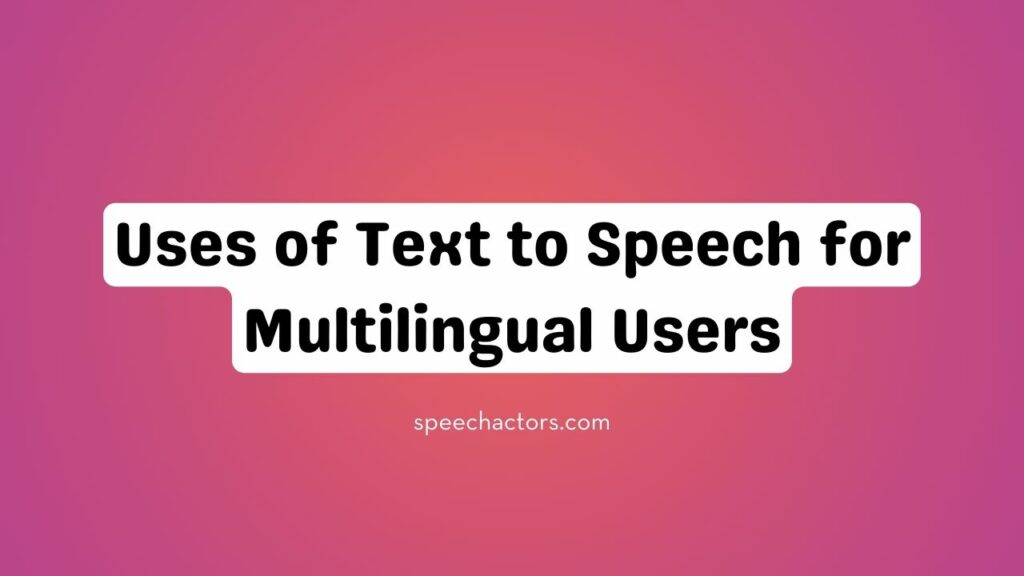Text-to-Speech (TTS) technology converts written text into natural-sounding speech, making digital content more accessible and engaging for multilingual users. In today’s globalized world, multilingual accessibility plays a key role in connecting users from diverse linguistic backgrounds.
TTS enables users to listen to content in their preferred language, enhancing comprehension, learning, and overall user experience. By bridging language barriers, it empowers individuals to access information seamlessly, whether for education, work, or daily life, making digital platforms more inclusive and user-friendly for audiences worldwide.
How TTS Supports Multilingual Users
Text-to-Speech (TTS) supports multilingual users by converting written text into natural-sounding audio in multiple languages. Modern TTS systems can speak fluently in English, Spanish, Hindi, Mandarin, Arabic, and many other languages, making digital content accessible to diverse audiences.
By offering clear speech output, TTS bridges language barriers for global learners who may struggle with reading or understanding foreign text. This helps students, professionals, and everyday users engage with knowledge in their preferred language.
Furthermore, TTS benefits remote audiences and international communication by ensuring that messages, lessons, and content reach people across different countries with ease and inclusivity.
Key Uses of TTS for Multilingual Audiences
Language learning and pronunciation practice: TTS helps learners hear accurate word pronunciation, improving listening skills and supporting effective language acquisition.
Accessibility support for non-native speakers: TTS converts written text into clear speech, making information easier to understand for people still developing language proficiency.
Multilingual e-learning content delivery: TTS enables educational platforms to offer lessons in different languages, ensuring global learners can access study materials.
Enhancing engagement in international digital platforms: TTS increases participation by providing voice output in users’ preferred languages across apps, websites, and media platforms.
Assisting businesses in cross-language communication: TTS allows companies to interact with international clients and teams by converting text into speech across multiple languages.
Strategies to Implement TTS for Multilingual Users

Text-to-Speech (TTS) can make content more inclusive when it supports multiple languages. Choosing tools like Speechactors, which provide wide language coverage, helps users access information in their native tongue.
Integrating TTS into apps, websites, and e-learning platforms ensures that learners, readers, and customers can engage with content in real time. Customizing voices to match regional accents and tones adds familiarity, making the listening experience natural.
Maintaining clarity and consistency across languages is also essential, as it guarantees the same message is understood everywhere without confusion. These strategies together create a smooth multilingual experience for all users.
Benefits for Educators and Content Creators
Reaching a global audience: TTS makes content available in multiple languages and accents, allowing educators and creators to connect with learners and viewers worldwide.
Reducing localization costs: TTS eliminates the need for expensive dubbing or voiceover services by generating natural-sounding voices, cutting down translation and production expenses.
Creating inclusive experiences for diverse users: TTS ensures accessibility for individuals with disabilities, language barriers, or different learning styles, making educational and creative content universally usable.
Boosting engagement and comprehension: TTS improves retention by combining audio with text, helping users understand complex material and stay more engaged with lessons, videos, or digital content.
Future Trends in Multilingual TTS
Future trends in multilingual TTS focus on smarter AI voices, wider language coverage, and seamless global communication.
AI-driven voice generation will learn context, accents, and co-articulation to produce natural pronunciation that sounds human in everyday speech. Models will adapt to user intent, switching tone and rhythm for storytelling, training, or customer support in real time.
Furthermore, platforms will expand regional language support, adding dialects, mixed codes, and script variants so more people can hear content in their own style.
Additionally, multilingual TTS will power global digital communication across apps, call centers, education, media, and accessibility tools, removing language barriers at scale. Expect faster inference, lighter on-device models, and consistent quality across languages for a smooth, human-like listening experience.
Frequently Asked Questions (FAQs)
How does TTS help non-native speakers?
TTS reads text aloud clearly, helping non-native speakers understand pronunciation, tone, and meaning. Studies show listening while reading can improve language comprehension by up to 40%.
Can TTS support all global languages?
TTS supports over 100 languages, including widely spoken and regional languages. Advanced systems adapt accents and dialects, making communication natural for global users.
How customizable are the voices for different languages?
Voices in TTS are highly customizable with pitch, speed, tone, and gender options. Users can select voices that feel natural and match regional accents for better engagement.
Can multilingual TTS integrate with existing platforms?
Multilingual TTS easily integrates with apps, e-learning tools, websites, and mobile platforms using APIs. Companies like Duolingo and Google use TTS to enhance accessibility.
How does TTS improve learning and comprehension for multilingual users?
TTS strengthens reading, listening, and pronunciation simultaneously. Research shows learners retain up to 60% more information when combining audio with text across multiple languages.
Conclusion
Conclusion: Text-to-speech for multilingual users bridges language barriers, making content accessible, engaging, and inclusive. From enhancing e-learning and global communications to streamlining content creation, multilingual TTS empowers users to connect across cultures effortlessly.
By adopting these solutions, creators, educators, and businesses can expand their reach and provide richer experiences for diverse audiences. Explore Speechactors today to harness the full potential of multilingual audio content and transform the way your message resonates worldwide making every word count, no matter the language.
